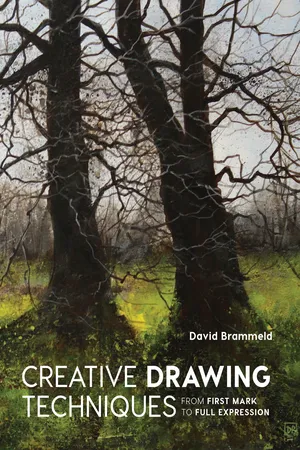
- 176 pages
- English
- ePUB (mobile friendly)
- Available on iOS & Android
eBook - ePub
About this book
Drawing is at the heart of all art and this inspiring book gives new ideas and techniques to help artists, whatever their ability, realize their visions. Based on years of teaching and artistic experience, Creative Drawing Techniques explains how to get the best out of different materials and express ideas, gain confidence and develop skills on paper. It emphasizes the importance of looking, analyzing and interpreting what we see. In doing so, it provides a rich and inspiring account of a basic but sophisticated need to make sense of the world around us. This book will be valued by everyone who wants to pick up a pencil and enjoy the creative art of drawing.
Frequently asked questions
Yes, you can cancel anytime from the Subscription tab in your account settings on the Perlego website. Your subscription will stay active until the end of your current billing period. Learn how to cancel your subscription.
No, books cannot be downloaded as external files, such as PDFs, for use outside of Perlego. However, you can download books within the Perlego app for offline reading on mobile or tablet. Learn more here.
Perlego offers two plans: Essential and Complete
- Essential is ideal for learners and professionals who enjoy exploring a wide range of subjects. Access the Essential Library with 800,000+ trusted titles and best-sellers across business, personal growth, and the humanities. Includes unlimited reading time and Standard Read Aloud voice.
- Complete: Perfect for advanced learners and researchers needing full, unrestricted access. Unlock 1.4M+ books across hundreds of subjects, including academic and specialized titles. The Complete Plan also includes advanced features like Premium Read Aloud and Research Assistant.
We are an online textbook subscription service, where you can get access to an entire online library for less than the price of a single book per month. With over 1 million books across 1000+ topics, we’ve got you covered! Learn more here.
Look out for the read-aloud symbol on your next book to see if you can listen to it. The read-aloud tool reads text aloud for you, highlighting the text as it is being read. You can pause it, speed it up and slow it down. Learn more here.
Yes! You can use the Perlego app on both iOS or Android devices to read anytime, anywhere — even offline. Perfect for commutes or when you’re on the go.
Please note we cannot support devices running on iOS 13 and Android 7 or earlier. Learn more about using the app.
Please note we cannot support devices running on iOS 13 and Android 7 or earlier. Learn more about using the app.
Yes, you can access Creative Drawing Techniques by David Brammeld in PDF and/or ePUB format, as well as other popular books in Art & Art General. We have over one million books available in our catalogue for you to explore.
Information
CHAPTER 1
GETTING STARTED
This book does not make presumptions about a particular level of ability, about existing knowledge or skills in the reader. It aims to give inspiration and encouragement to the beginner and experienced artist alike.

Model Radio, pastel on A1 paper.
Starting from this premise, it is helpful to start at the beginning, with a level playing field, explaining materials – much in the same way as a story unfolds after introducing the characters and setting the scene. It is prudent, therefore, to assume that everyone has a different starting point, since everyone has a different knowledge and experience base. The book can then guide the reader freely through the many discoveries that lie ahead.
The two separate components of drawing
It is helpful to separate the two main parts to the act of drawing:
Firstly, the technical side, which involves, for example, knowledge and handling of materials, developing and mastering skills, and so on: the practical element.
Secondly, the ‘seeing’ element, which involves training the eye to ‘look’ closely and analyze what it is we want to commit to paper. This is the cognitive element, and is about hand/eye coordination and how we learn to translate what we see. Naturally, we all see things differently. That is not to say that any one view is the definitive one; on the contrary, I want you to discover your own individual way of looking at and representing things, your vision. Your unique take on the world is a valuable thing and will help your work stand out from the crowd.
If you are aware of the distinction between the technical side and the creative/seeing element, it can help pinpoint areas for development.
What do I need to start drawing?
Drawing requires only the simplest and most basic of materials: a pencil, an eraser, a piece of paper, plus either a craft knife or sharpener for the pencil, and that’s about it. These materials are traditional and universally used, as it is natural to reach for a pencil and piece of paper when sharing a thought or explaining an idea to someone. A pencil is possibly the most widely used instrument for markmaking – it’s a familiar tool. From our early days of school we have reached for a pencil to write, scribble, share ideas, make notes, draw or otherwise express ourselves.

I’m working on an A2 pad of smooth creamy heavyweight paper with a mechanical pencil. Different papers give different results – most of my drawing is done on a whiter paper than this, and I also prefer a bit more ‘tooth’. The drawing therefore had a different look and I found I couldn’t achieve the level of tonal control that I normally take for granted. It was a beautifully smooth drawing surface, though.
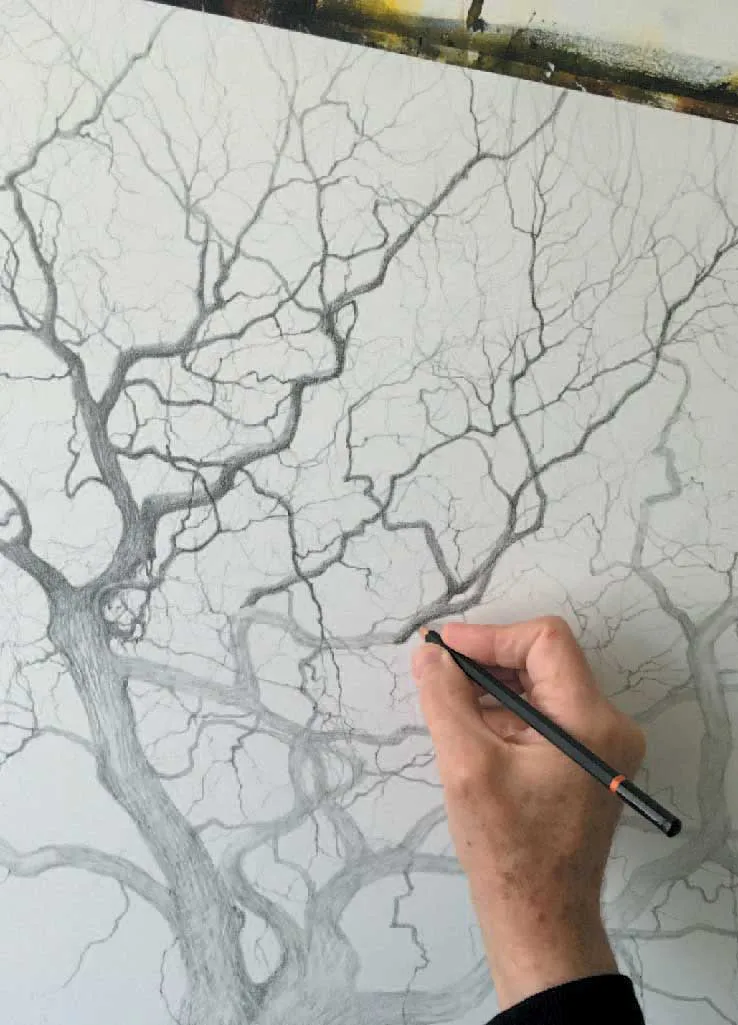
Moorland Tree in pencil. Sometimes for a change and if the right picture comes along, my response might be to produce a really ‘tight’ drawing: a controlled drawing where I may use just one pencil throughout, with very little eraser work. One of the challenges is to keep the white of the paper ultra clean for the sky, which is very difficult because when you are doing a lot of fine detailed work you need to rest your hand on the surface for control. The point of the pencil should be kept sharp. The drawing needs to be accurate from the very beginning because rubbing out might mark the paper.

This drawing might seem as though it was tedious to work on. Not at all – the slower pace means that marks are more considered, so there was hardly any eraser work involved. It was totally controlled with pencil pressure and layering to build tonal contrast.
Great results can be achieved with just a couple of pencils: a 2B and a 6B, two erasers – a hard eraser and a soft putty rubber, plus a few sheets of good quality cartridge paper or sketchbook. Of course, you will need a board and some clips or masking tape to keep the paper in place, and an easel or table to rest the board on. You will also need something to draw – your subject.
Studio or plein air?
Artists broadly fall into two distinct categories, I think: they are either studio painters – working from photos, sketches, still life, life models and so on (or a combination of these) in a well-equipped work space or at the corner of a kitchen table; or they paint ‘en plein air’ – working outside in all weathers and responding directly to what they see in front of them, whether it is an urban cityscape or the natural landscape.
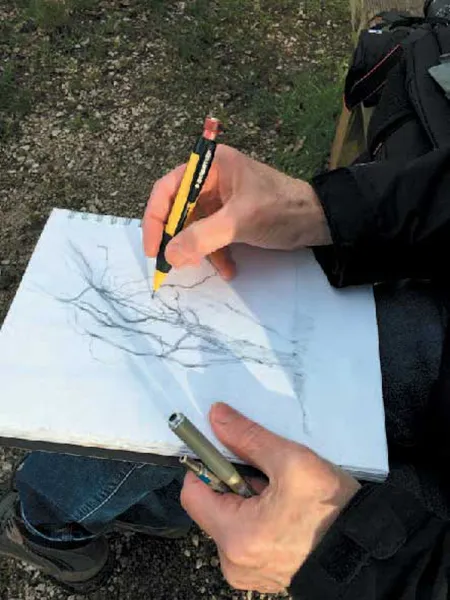
A sketching trip in winter – seemed like a good idea at the time – but the sunlight and shadows belie the fact that this was a bitterly cold day. Despite the cold fingers I managed to produce some sketches.
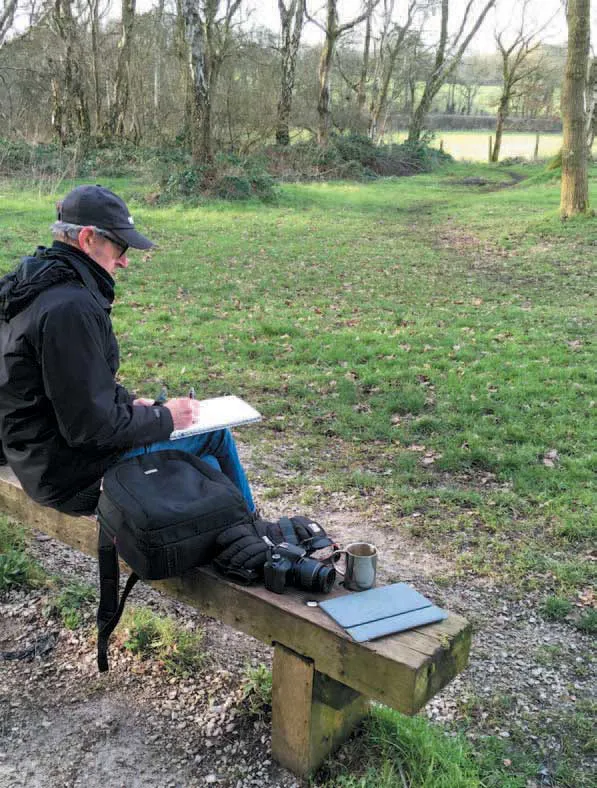
It was pleasant enough sitting sketching trees on a well-placed bench in a country park with camera, pencils and hot coffee, as long as the sketches were brief.

In this pastel landscape, the background layers have been built up carefully, creating opacity and variety. The main tree has been established in a loose manner and some drawing has been done to suggest smaller branches. Then it was back to the undergrowth to suggest variety and texture.
The plein air painter is concerned with capturing a moment in time, prevailing light and weather conditions, moving objects like people, transport, cloud formations, the sea and so on. All these elements combine to give an impression of a fleeting moment in time. They are always painting against the clock, battling against constraints of weather or light. They paint with just enough detail to give an impression of what it was like to be there in that location, at that particular moment in time – afterwards that moment is gone, the painting is finished and a new picture calls.
Studio painters have the advantage of having all their materials to hand, a controlled light source and environment, and once they are set up and ready to go they can focus on the job in hand, go for a break, and return sometime later to continue. It’s a consistent, predictable way of working.
It could be argued that the well-equipped and organized plein air painter also has their materials close by, but there will always be uncontrollable elements, such as the weather, intruding on time and focus. Working indoors, the studio painter has the flexibility to paint all day or night depending on preference because they have everything to hand: an image, sketch or still-life composition or life model to work from and a comparatively stable and comfortable environment in which to work. They can work for a few minutes or hours here and there as time permits or finish a work in one sitting.
The joy of drawing or painting outdoors
When I exhibited for the first time in France a few years ago, I had taken various painting materials in the boot of the car. While staying at a château for a workshop, I walked round the grounds one beautiful warm evening, looking for subjects to paint. It was a perfect location.

On a very hot evening in France, I had taken a box of watercolours, water, brushes and a small sketchbook to try to capture something of the beautiful ambience of my surroundings. I simply laid the sketchbook on the grass and enjoyed dribbling paint and sketching, not worrying too much about the quality of the drawing itself. Such is the emotional power of a sketch that just a few simple lines can evoke the moment when looking back. When I see this sketch it brings back the memories of people, place, ambience and so on.

Adding watercolour to these pencil studies in my sketchbook brought them to life. It was good to do this while everything was fresh in the memory. I didn’t make the sketches for any other reason than the enjoyment of looking and drawing.
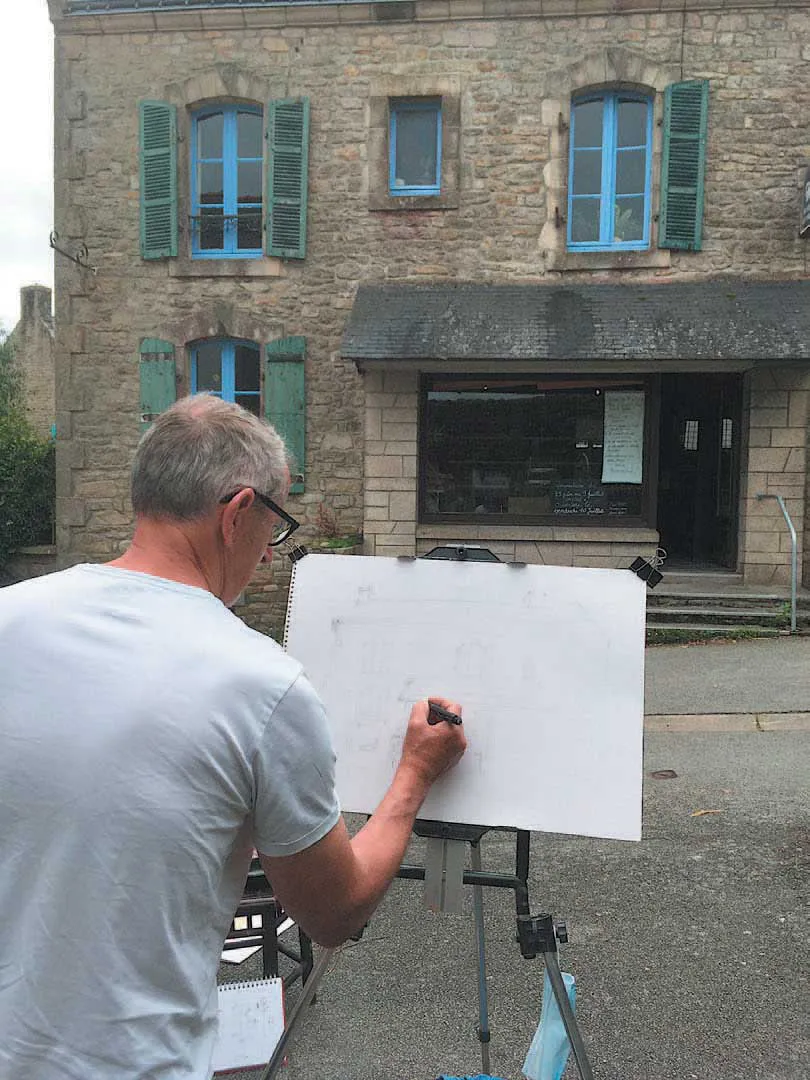
Here I am in Brittany working on a sketch of a boulangerie. I was planning to do a pencil drawing first, followed by watercolour washes, then pen and ink. I later applied stronger colour as the work progressed. I thought watercolour would be a good medium to enable me to work quickly and spontaneously. There was a time constraint – it was for a competition and the work had to be completed by a certain time.

In the absence of a conveniently placed seat or dry grass to sit on, a lot of my sketching is done standing. I like the feeling of being able to move around a subject easily and quickly, even though it’s a bit more awkward holding the sketchbook in one hand.
It was a great moment just to choose a spot, sit on the grass and sketch whatever took my interest. I worked in pencil first then dribbled some wate...
Table of contents
- Cover
- Halftitle
- Title
- Copyright
- Contents
- Introduction
- 1 Getting Started
- 2 The Language of Drawing
- 3 Developing Your Style and Ideas Through Sketching
- 4 Choosing a Subject
- 5 Drawing from Life or from Photographs
- 6 Developing a Drawing
- 7 Exploring the Potential of Dry Drawing Media
- 8 Working with Wet Drawing Media
- 9 Projects and Practice
- 10 Presenting your Work
- Conclusion
- Selected Bibliography
- Recommended Materials and Suppliers
- Index